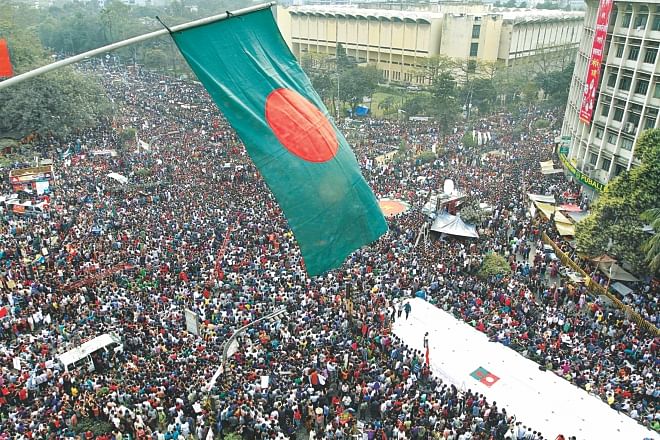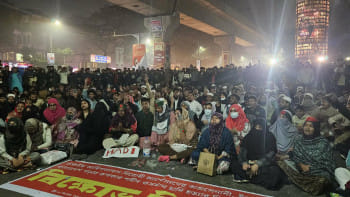'Shahbagh Protest': Spirit, identity and justice

Ganajagaran Mancha has been on the street for the last eleven months with their demand for capital punishment of the convicted war criminals, ban of the Bangladesh Jamaat-e-Islami party from politics and boycott of institutions affiliated with the party. It started on February 5, 2013, when thousands of people stormed Shahbagh Square to protest the verdict on Abdul Quader Mollah who was sentenced to life in prison by the International Crimes Tribunal. Protesters considered the punishment too lenient given that he was convicted on five of the six counts of gruesome war crimes. The protest soon spread across the country. Abroad, the protest attracted massive support from non-resident Bangladeshis.
World famous sociologist C. Wright Mills precisely observed that, “Every revolution has its counterrevolution – that is a sign the revolution is for real”. The Shahbagh Protest appeared to be a threat to the very existence of Jamaat. To fight back, they resorted to old strategies of creating communal frenzy and violence. Jamaat and its allies started counter-demonstration casting a fictitious allegation against the Ganajagaran Mancha of demeaning Islam and Prophet Muhammad (PBUH). They have been publishing concocted news and photos to portray the protesters as anti-Islamic, even atheist. Since the beginning of the war crimes trial they have been perpetrated attacks on minority communities. Ramu attack was only the beginning. In each of these cases of attack on minorities, Jamaat was found guilty with its local cohorts from different political parties, even AL.
The Shahbagh movement started and spread spontaneously. No political party in Bangladesh holds the moral authority to trigger a spontaneous popular movement. But spontaneity is always political. That's why it has to identify itself with one of the existing political forces.
In Shahbagh's case, initially BNP had lent a guarded support to the movement. But it got out of the painful embrace at the earliest opportunity. “This opportunity came with the discovery of atheist blogs reportedly of slain blogger 'thaba baba'. Very quickly the BNP started denouncing Shahbag as an anti-Islamic movement.”
The AL government was as astonished as anyone by the scale of popular rejection of the verdict delivered by the court. Many patriotic dissenters raised their finger at the verdict as an indication that “the ruling Awami League is secretly using the ICT verdicts to negotiate a deal with Jamaat, in order to break its alliance with the opposition BNP, and thereby, to ensure another term of office for itself?” At the beginning, protesters even denounced veteran AL leaders who came to express solidarity with the movement. However, within few weeks, Awami League had successfully grasped the leadership of the movement.
Left leaning parties have played a significant role in the movement. But they are too weak to carry forward the baton.
Soon after the rise of Shahbagh, a militant Islamic force under the banner of Hefazat-e-Islam propped up with the blessings of BNP and Jamaat. Hefazat-e-Islam is a banner of Quomi madrasas who are generally known to be in conflict with Jamaat. Some of its leaders are part of BNP-led 18 party alliance. It seems that BNP helped to bring the two antagonist communal forces together. In line with Jamaat's propaganda, Hefazat-e-Islam demanded capital punishment of the leaders of Shahbagh movement accusing them of demeaning Islam. When they were asked about any proof in support of their allegation they simply failed to produce any substantive document. Rather, they referred to contents of various websites and blogs that were later proved as fake, photo shopped and provocative. On May 5, Hefazat-e-Islam protesters, aided by Bangladesh Jamaat-e-Islami and its youth wing Chattra Shibir, gathered a massive crowed at Motijheel Shapla Chattar. They indulged in violent activities in Dhaka that included arson, vandalism and burning of books. The Government used force to tackle them. Later, the government indicated an official death toll of 11.
An important aspect of the Shahbagh protest is omnipresence of virtual space. Popular social media sites like Facebook, Twitter continue to be the main source of information about both protesters and dissenters of the movement. Live debate took place for and against Shahbagh protest. Different sorts of online propaganda activities also went viral. We find a similarity with global spirit of online activism inspired by different popular movements around the world since the spark of Arab Spring.
Subsequently, the parliament passed a bill on July 9, 2013, incorporating a number of new provisions in the International Crimes (Tribunal) Act, 1973. With the inclusion of the new provisions, trial of a political party that worked against the liberation of Bangladesh could also be held on the same charge, and the government can file appeals with the Appellate Division against acquittal order of a tribunal.
On September 17, 2013, Bangladesh Supreme Court found Abdul Quader Molla guilty of murder and other war crimes and ordered his execution, converting his life sentence to death sentence. Finally, on December 12, for the first time in Bangladesh's history, a convicted war criminal met his due.
Every movement generates questions. The Shahbagh protest evokes the fundamental question of secularism, which has been kept unaddressed, even distorted, over the years. In the particular context of South Asia, nation building efforts cannot shy away from the question of relations between state and religion. In 1947, British colonialism came to an end. But the anti-colonial nationalist movement failed to resolve the question of state-religion relations which ultimately gave birth to two states: India and Pakistan. This is not the problem of nationalism rather communalism that affected the nationalist spirit. Emergence of Bangladesh realized the long cherished foundation of a state based on the principle of secularism which no way goes against any religion, particularly Islam. But the secularization of society and polity is yet to find a strong foothold in Bangladesh.
Since Independence, all major political parties have, in some form or the other, aided in the rehabilitation and reinstatement of the communal forces. Rise of Jamaat is the outcome of failures of our secular institutions to address communalism. The Shahbagh movement brought into surface the deep and widespread revulsion against politicization of religion and communalism.
The movement has its own shortcomings. Anti-incumbent sentiment has weakened the spirit of a broad-based platform. People do not want to be used by AL, just as they don't want to be used by BNP, JI or JP like political forces. The movement is overwhelmingly dominated by participants from middle class background. The poor and working class was conspicuous in their absence at Shahbagh. The spread of the movement was limited to urban areas. So the communal forces got an easy opportunity to manipulate a significant portion of the village population against the movement.
What made possible the emergence of Bangladesh? Professor Abdur Razzak's comment has the best answer. He had said, “Collective will of Bangladeshi people to be liberated and establish their nation state.” A movement is an expression of collective will. Every time when the nation is in a crisis people have to assert their collective will. It happened in 1952, 1969, 1971, 1990 and finally in 2013. The Shahbagh movement has saved us from forgetting our fundamentals. It is a demand for justice, not revenge.
The writer is Sr. Editorial Assistant, The Daily Star.
E-mail: [email protected]

 For all latest news, follow The Daily Star's Google News channel.
For all latest news, follow The Daily Star's Google News channel. 



Comments